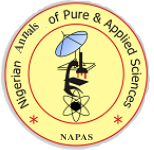Prevalence of Hydatidosis and Characterization of Echinococcus Granulosus in Cattle, Goats and Swine in Benue State, Nigeria
Abstract
Hydatidosis is a serious zoonotic disease caused by Echinococcus granulosus species complex. This research was conducted to determine the prevalence of infection of the disease in Benue State, Nigeria. The study area was divided into three (3) locations: Makurdi, Otukpo and Adikpo abattoirs. The carcass of each animal which included Cattle, goats and pigs was inspected carefully for the presence of hydatid cysts and infection. The organs infected and the numbers of cysts were recorded. Animal sex and age were also recorded. Hydatid cysts collected were preserved in 70% ethanol and transported to the laboratory for analysis. In the laboratory, cysts sizes were measured, microscopic examination of hydatid fluid was performed to determine cysts fertility and Haematoxylin and eosin staining technique was performed. Overall prevalence was 30.86% (679/2200), infection rates in the sampling sites were significant (P<0.05), with the lungs being the most infected organ (42.36%), followed by the liver (19.36%), while mixed infections involving the liver and the lungs were detected in 2.91% of the livestock sampled. The cysts were examined under the microscope to determine fertility, out of the 1296 hydatid cysts collected and examined, (52.40%) of the hydatid cysts were fertile, (35.80%) were sterile while (11.80%) were calcified. Lung cysts were found to be more fertile (64.27%) compared to liver cysts (35.73%). Prevalence based on age was statistically significant (P<0.05) with adult more infected (33.01%) than the young (21.88%). Infection rate was seen to be more during the wet season (34.38%) than during the dry season (25.78%). There was a direct relationship between age, number and size of hydatid cysts as the number and size of the cysts increase with increase in age of the animal. The outcome of this study justifies the need for comprehensive intervention in hydatidosis management and prevention
References
Addy, F., Alakonya, A., Wamae, N., Mbae, C., Mulinge, E., Zeyhle, E., Wassermann, M., Kern, P. and Romig, T. (2012). Prevalence and diversity of cystic echinococcosis in Livestock in maasai land, Kenya. Parasitology Research journal.111 (6) 2289-2294
Ahmed, M. E., Bashir, S., Martin, P. G and Imadeldin, E.(2018). First molecular characterization of Echinococcus granulosus (sensu stricto) genotype 1 among cattle in Sudan. BMC Veterinary Research 14:36 DOI 10.1186/s12917-018-1348-9
Azami, M. Anvarinejad, M., Ezatpou, B.and Alirezaei, M.(2013).Prevalence of hydatidosis in slaughtered animals in Iran.Turkish journal of parasitology.37: 102-106
Craig PS, McManus DP, Lightwolers MW, Chabalgoity JA, Garcia HH, Gavidia CM, Gilman RH, Gonzalez AE, Lorca M, Naquira C, NietoA, Schantz PM (2007). Prevention and control of cystic echinococcosis. Latent Infectious Disease. 7:385-394.
Gareh A, Saleh AA, Moustafa SM, Tahoun A, Baty RS, Khalifa RMA, Dyab AK, Yones DA, Arafa MI, Abdelaziz AR, El-Gohary FA, Elmahallawy EK. (2020). Epidemiological, Morphometric, and Molecular Investigation of Cystic Echinococcosis in Camel and Cattle from Upper Egypt: Current Status and Zoonotic Implications. Frontier Veterinary Science. 4(8): 750-640. doi: 10.3389/fvets.2021.750640.
Haleem S, Niaz S, Qureshi NA, Ullah R, Alsaid MS, Alqahtani AS, Shahat AA. (2018). Incidence, Risk Factors, and Epidemiology of Cystic Echinococcosis: A Complex Socioecological Emerging Infectious Disease in Khyber Pakhtunkhwa, Province of Pakistan. Biomedical Research International Journal. 12:5042430. doi: 10.1155/2018/5042430.
Kamali M, Yousefi F, Mohammadi M J, Alavi S M, Salmanzadeh S, (2018). Hydatid Cyst Epidemiology in Khuzestan, Iran: A 15- year Evaluation. Arch Clinical Infectious Disease. 13(1):13765. doi: 10.5812/archcid.13765.
Kebede, N., Mitiku, A and Tilahun,G (2009). Hydatidosis of Slaughtered animals in Bahir Dar Abattoir, Northwestern Ethiopia. Tropical Animal health Production. 41(1): 43-50
Keuroghlian, A. and A.L.J. Desbiez. (2010). Biometric and age estimation of live peccaries in the Southern Pantanal, Brazil. Suiform Soundings 9(2): 24-35
Manyuele, C.T. (2014). Prevalence of Cystic Echinococcosis and diversity of Echinococcus Granulosus Infection in sheep in Olokurto Division, Narok County, Kenya.
Mekuria, S., &Hirpassa, L. (2015). Prevalence and Viability of Hydatidosis in Cattle Slaughtered at Sebeta Municipal Abattoir, Central Ethiopia. Ethiopian Veterinary Journal. 23(1) 24-41
Okolugbo, B., Luka, S. Ndams, I (2014). Enzyme-Linked Immunosorbent Assay (Elisa) In the Serodiagnosis of Hydatidosis in Camels (Camelus dromedarius) And Cattle In Sokoto, Northern Nigeria. The Internet Journal of Infectious Diseases. 13:1-6.
Okolugbo, B.C., Luka, S.A Ndams, I.S. (2013). Hydatidosis of Camels and Cattle Slaughtered In Sokoto State, Nothern Nigeria. Food Science and Quality Management. 21:40-45. ISSN 2224-6088.
Okoye, J., Yan, H., Magaji, A., Luka, J., Zhu, G., Isaac, C., Odoya, M., Wu, Y., Alvi, M., Muku, R. Fu, B. and Jia,W. (2020). Cystic echincoccosis in Nigeria: first insight into the genotype of echinococcus granulosus in animals 392(12): 1-10.
Omer RA, Dinkel A, Romig T, Mackenstedt U, Elnahas AA, Aradaib IE,. A molecular survey of cystic echinococcosis in Sudan.(2010) Veterinary Parasitology ;169:340–6.
Pedro L, Garcia HH, Gonzales AE, Bonilla JJ, Verastegui M, Gilman RH.(2005). Screening for cystic echinococcosis in an endemic region of Peru using portable ultrasonography and the enzymelinked immunoelectrotransfer blot (EITB) assay. Parasitology Research; 96: 242-246.
Rabi’u, B. and Jegede, O. (2010). Incidence study of hydatidosis among slaughtered animals at Kano abattoir, Nigeria. Biological and Environmental Science Journal for the Tropics, 7(2): 29-34.
Romig, T., Ibrahim, K., Kern, P. and Omer, R.A. (2011). A molecular survey on cystic Echinococcus in Sinnar area, Blue Nile estate (Sudan). Chinese. Medical Journal. 124: (18) 2829-2833.
Singh BB, Sharma JK, Ghatak S, Sharma R, Bal MS, Tuli A, Gill JPS (2012). Molecular epidemiology of Echinococcosis from food producing animals in north India. Veterinary Parasitology Journal 86(34):503–506.
Thrusfield, M. (2005). Vertinary Epidemiology. 3 rd edition.UK: Blackwell Science Ltd. Oxford: 117- 198.
Downloads
Published
How to Cite
Issue
Section
License
Copyright (c) 2023 Okoh, M.E., Omudu E. A., Atu, B. O., Happyness I Obadiah

This work is licensed under a Creative Commons Attribution-ShareAlike 4.0 International License.



 Contact Us
Contact Us Editorial Team
Editorial Team Join As A Reviewer
Join As A Reviewer  Request For Print Copy
Request For Print Copy


 Cprint Publishers
Cprint Publishers